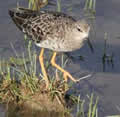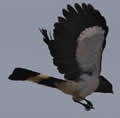2017/09 Part 2 Amboseli - Mon am Leaving Amboseli |
|||||
Monday September 18th
Nzuki picked us up at 7.30 am to take us to Namanga and the border with Tanzania. We had a call from Elvira to ask how the trip was going. She is the lady who had been helping us plan our trip with Tano Safaris since last November. Of course we said things were going great.
 Nzuki said we had enough time to stop along the way if we saw anything interesting. We were going out via a different gate so we’d be seeing different country on the north side of the swamps. We had an additional passenger, a young man involved in wildlife protection who needed a ride to the border.
Nzuki said we had enough time to stop along the way if we saw anything interesting. We were going out via a different gate so we’d be seeing different country on the north side of the swamps. We had an additional passenger, a young man involved in wildlife protection who needed a ride to the border.
There were familiar birds in the swamp, whistling ducks and Egyptian geese, and these ducks, seen a  couple of days earlier but I forgot about them. I think they are knob-billed ducks, but these are females who don’t have the distinctive knob.
couple of days earlier but I forgot about them. I think they are knob-billed ducks, but these are females who don’t have the distinctive knob.
But we soon saw some new species. This black-winged stilt, named of course, for its long legs, can be found all over the world.
The ruff is a world traveler too, migrating all the way from Siberia, even though it looks a bit like an overweight sandpiper. The squacco is a mid-sized heron, pretty with its cinnamon and cream  colouring.
colouring.
 To our surprise we came across this well camouflaged cheetah snoozing in the bush. It obligingly raised its head for a photo and then went back to sleep.
To our surprise we came across this well camouflaged cheetah snoozing in the bush. It obligingly raised its head for a photo and then went back to sleep.
| Monday AM Leaving Amboseli (2.23) |
 |
|---|
 The enormous bird is a kori bustard, the heaviest African bird capable of flight. This one was walking and then
The enormous bird is a kori bustard, the heaviest African bird capable of flight. This one was walking and then  running, probably reluctant to spend the energy needed for a 747-like takeoff.
running, probably reluctant to spend the energy needed for a 747-like takeoff.
After passing a few giraffes, we saw this tawny eagle posing for us.
In contrast, this bushbuck stayed on the other side of the thicket the whole time. Nzuki said that the bushbuck is the second smallest antelope and it’s on all carnivores’ snack menu, so it’s shy  and secretive, rarely seen in daylight. I’ve included the fuzzy picture below as we never saw another one.
and secretive, rarely seen in daylight. I’ve included the fuzzy picture below as we never saw another one.
Nearby was this gerenuk, easier to see, stretching up to feed on the upper branches.
This raptor took off on seeing us; Nzuki identified it as a goshawk, and our book says that it is a dark chanting goshawk. 
In the bush behind us were these two kudu and we were lucky to see them too as they spend most of their time in thorny thickets, out of sight. 
Nzuki had pulled off the road so traffic could get through, but he’d gone a little too far and one drive wheel was off the shoulder. This was a good opportunity for our passenger to show his gratitude by pushing us back onto the road.
Our last discovery, appropriately, was this white-bellied goaway bird, named for its distinctive call.
 We left the park via the Meshanani Gate and bounced our way along the park’s approach road, with a fair amount of driving along the smoother shoulders.
We left the park via the Meshanani Gate and bounced our way along the park’s approach road, with a fair amount of driving along the smoother shoulders.